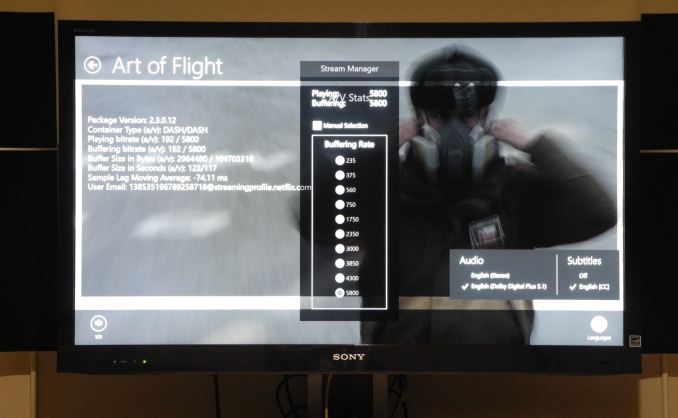The NVIDIA GeForce GTX 750 Ti and GTX 750 Review: Maxwell Makes Its Move
by Ryan Smith & Ganesh T S on February 18, 2014 9:00 AM ESTHTPC Aspects : Network Streaming Performance
Windows 7-based HTPCs need hardware acceleration in both Adobe Flash and Microsoft Silverlight for optimal streaming performance with YouTube and Netflix. The move to Windows 8.1 has made Silverlight unnecessary. The Netflix app on Windows 8.x brings a HTPC's capability on par with dedicated streaming consoles, with support for Super HD (6 Mbps) streams as well as Dolby Digital Plus bitstreaming support. The latest app also renders the video in such a way as to make taking screenshots an exercise in frustration.
As the above photograph shows, the Netflix app can be set to bitstream Dolby Digital Plus to the AV receiver and the 750Ti supports it. The video and audio streams are at 5.8 Mbps and 192 kbps respectively. It is not immediately evident as to whether GPU acceleration is being utilized. However, tracking the GPU / VPU loading and PC power consumption numbers make it obvious that it is not software decode at work in the Netflix app.
Unlike Silverlight, Adobe Flash continues to maintain some relevance right now. YouTube continues to use Adobe Flash to serve FLV (at SD resolutions) and MP4 (at both SD and HD resolutions) streams. YouTube's debug OSD indicates whether hardware acceleration is being used or not.
Similar to our Netflix streaming test, we recorded GPU / VPU loading as well as power consumption at the wall when streaming the 1080p version of the sample YouTube clip. The table below presents the relevant numbers for various configurations and streaming services.
| Streaming Video Performance | ||||||
| Netflix | YouTube | |||||
| GPU/VPU Load | Power | GPU/VPU Load | Power | |||
| NVIDIA GeForce GTX 750 Ti | 11.95/12.65% | 56.44 W | 16.26/15.74% | 55.45 W | ||
| NVIDIA GeForce GT 640 | 5.99/25.80% | 58.89 W | 15.57/25.72% | 58.93 W | ||
| AMD Radeon HD 7750 | 0.72% | 66.79 W | 3.57% | 67.11 W | ||
NVIDIA has been touting Maxwell's low power nature, and it proves to be the best of the three candidates in terms of power efficiency when it comes to GPU support for streaming services.












177 Comments
View All Comments
MrSpadge - Tuesday, February 18, 2014 - link
To be fair GTX650Ti Boost consumes ~100 W in the real world. Still a huge improvement!NikosD - Tuesday, February 18, 2014 - link
Hello.I have a few questions regarding HTPC and video decoding.
Can we say that we a new video processor from Nvidia, a new name like VP6 or more like a VP5.x ?
How Nvidia is calling the new video decoder ?
Why don't you add a 4K60 fps clip in order to test soon to be released HDMI 2.0 output ?
If you run a benchmark using DXVA Checker between VP5 and VP6 (?) how much faster is VP6 in H.264 1080p, 4K clips ?
Thanks!
Ryan Smith - Thursday, February 20, 2014 - link
NVIDIA doesn't have a name for it; at least not one they're sharing with us.NikosD - Thursday, February 20, 2014 - link
Thanks.Is it possible to try a 4K60fps with Maxwell ?
I wonder if it can decode it in realtime...
Flunk - Tuesday, February 18, 2014 - link
I think these will be a lot more exciting in laptops. Even if they're no where near Nvidia's claimed 2x Kepler efficiency per watt. On the desktop it's not really that big a deal. The top-end chip will probably be ~40% faster than the 780TI but that will be a while.dylan522p - Tuesday, February 18, 2014 - link
the 880 will be much more powerful than the 780ti. More than 40% even. They could literally die shrink and throw a few more SMX's and the 40% would be achieved. I would imagine either they are gonna have a HUGE jump (80% +) or they are gonna do what they did with Kepler and release a 200W Sku that is about 50% faster and when 20nm yields are good enough have the 900 series come with 250W Skus.Kevin G - Tuesday, February 18, 2014 - link
Very impressive performance for its power consumption. I can see an underclocked version of this card coming with a passive cooler for HTPC solutions. Perhaps that'd be a hypothetical GT740? I'm surprised that nVidia hasn't launched a mobile version of this chip. It seems like it'd be ideal for midrange laptops that still have discrete graphics.I suspect that the extra overclocking headroom is in reserve for a potential rebrand to a GTX 800 series product. (Though a straight die shrink of this design to 20 nm would provide even more headroom for a GTX 800/900 card.) nVidia could have held back to keep it below the more expensive GTX 660.
Though ultimately I'm left wanting the bigger GM100 and GM104 chips. We're going to have to wait until 20 nm is ready but considering the jump Maxwell has provided in the low end of the market, I'm eager to see what it can do in the high end.
DanNeely - Tuesday, February 18, 2014 - link
ASUS has a 65W TDP GT 640 with a big 2 slot passive heat sink (GT640-DCSL-2GD3); with the 750 Ti only hitting 60W a passive version of it should be possible at near stock performance. I suspect the 740 will be a farther cut down 3 SMM model which might allow a single slot passive design.PhoenixEnigma - Tuesday, February 18, 2014 - link
Passive cooling was my first thought as well - I've been looking for something to replace the 6770 in my HTPC with, and I wanted something both faster and passively cooled. There are already passive 7750s on the market, and the numbers in Bench put the 750Ti at about 9W more than then 7750 under real world load, so a vanilla 750 with a passive cooler should be entirely possible. Even a 750Ti might be doable, but that could be pushing things a little far.evilspoons - Tuesday, February 18, 2014 - link
I need a new half-height HTPC card, my 2.5 year old Asus Radeon 6570 bit the dust last month (sparkly picture, one particular shade of grey turned random colours). If they can work out the kinks in this thing and underclock it a bit, it sounds like a good candidate.It feels like it's been a long time since anything new showed up in the half-height video card game.